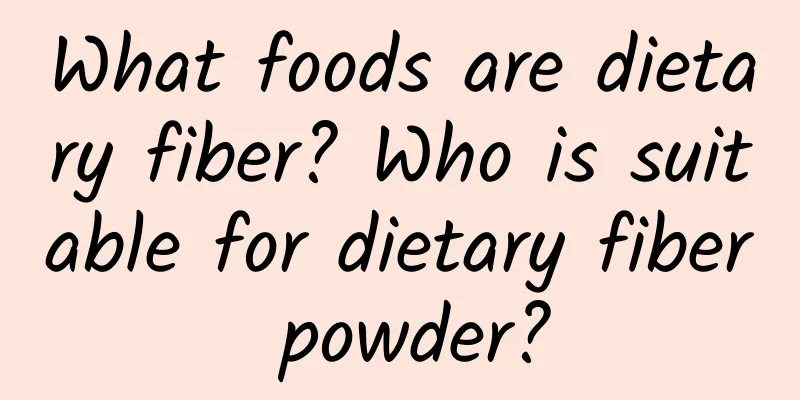What foods are dietary fiber? Who is suitable for dietary fiber powder?

|
Nowadays, everyone is living a relatively fast pace and busy life. Many people do not eat on time, like to eat and drink a lot, eat high-calorie foods, and do not like to eat vegetables and fruits. In fact, this is a very unhealthy eating habit. It is necessary to get enough dietary fiber through food. So what foods are dietary fiber? This must be a life issue that you are concerned about! Contents of this article 1. What foods contain dietary fiber? 2. What kind of people are suitable for eating dietary fiber powder? 3. What are the types of dietary fiber? 1What foods are dietary fiberThe first type of food rich in dietary fiber is grains, especially some whole grains, such as millet, corn, buckwheat, barley, and oats. The bran and whole grains of these grains contain more dietary fiber. The second type of food rich in dietary fiber is some vegetables, such as celery, leeks, spinach, and cabbage. These vegetables are also often important sources of dietary fiber. The third type of food rich in dietary fiber is some fruits, such as apples, bananas, oranges, and peaches, which also contain more dietary fiber. 2What kind of people are suitable for eating dietary fiber powder?1. People with dry stools and habitual constipation. These people suffer from insufficient dietary fiber in their daily diet. Dietary fiber can absorb water and increase its volume. When a certain amount is stored, it will stimulate the intestinal wall, forming a bowel movement consciousness, promoting bowel movements, and reducing the time food stays in the intestine. 2. People with abdominal bloating and indigestion. Since the usual eating habits consume relatively little dietary fiber, which slows down gastrointestinal motility, it is necessary to increase the intake of dietary fiber to promote gastrointestinal motility and improve the digestive system. 3. People with a small belly, excessive obesity, and puffiness. These are usually caused by eating high-calorie, high-fat foods and not exercising much. Increasing the dietary fiber content in the diet can reduce the intake of heat energy, reduce the digestion and absorption of nutrients in the intestine, and ultimately consume body fat to lose weight. 4. People with cardiovascular and cerebrovascular diseases such as hypertension, hyperlipidemia, arteriosclerosis, high cholesterol, etc. A balanced diet requires a sufficient amount of dietary fiber, which can absorb excess fat in the intestines and ease the absorption of sugar, thereby cleaning the blood, lowering blood pressure, blood sugar, blood lipids and high cholesterol, thereby reducing the incidence of some diseases. 5. People with diabetes, especially those with unstable blood sugar after meals. Soluble dietary fiber can absorb water and swell, increasing its volume by dozens of times to form a gel substance. On the one hand, it can make people feel full, and on the other hand, it can prolong the time that food stays in the stomach, slow down the absorption of sugar, avoid sudden high blood sugar, and help stabilize the condition of diabetic patients. 6. People with pigmentation, dark yellow face, dehydrated skin and acne. Supplementing with adequate dietary fiber can improve our skin problems. Dietary fiber can help remove excess free radicals in the intestines, has antioxidant properties, reduces damage to intestinal cells, and long-term consumption can delay aging. Dietary fiber also has an adsorption effect, which can absorb toxic substances in the intestines, inhibit the body's absorption of them, and make them directly excreted from the body. 7. Elderly friends. Many elderly people have problems with gastrointestinal digestion, constipation, etc., and need to supplement dietary fiber through diet for conditioning. 8. People who have irregular diet and need balanced dietary nutrition. Many people do not eat on time, like to eat and drink a lot, eat high-calorie foods, and do not like to eat fruits and vegetables. In fact, this is a very unhealthy eating habit. It is necessary to get enough dietary fiber through food. 3What are the types of dietary fiber?1. Insoluble Fiber Cellulose, hemicellulose and lignin are three common types of insoluble fibers that exist in plant cell walls. Insoluble fibers can reduce the risk of colon cancer. They can also prevent constipation and diverticulitis by absorbing toxic substances in food, and reduce toxins excreted by bacteria in the digestive tract. 2. Water-soluble fiber Pectin and gum are water-soluble fibers, which exist in non-fibrous substances in nature. Common foods such as barley, beans, carrots, citrus, flax, oats and oat bran are rich in water-soluble fibers. Water-soluble fibers can slow down digestion and excrete cholesterol most quickly, help regulate immune system function, and promote the excretion of toxic heavy metals in the body. Therefore, it can keep blood sugar and cholesterol at the most ideal level, and can also help diabetic patients improve insulin levels and triglycerides. |
Recommend
Should I style my hair for a boy when taking wedding photos? What is the best hairstyle for a boy when taking wedding photos?
Since most people only take wedding photos once, ...
What foods are better for increasing milk production?
Many mothers worry whether their breast milk can ...
Can I still get pregnant after having my uterus removed?
The uterus is an important organ of women and the...
What to do if estradiol is low during pregnancy
Estradiol is also a sex hormone. Many women will ...
What contraceptive method is good? Is the contraceptive method of 7 before and 8 after reliable?
Many young couples will take some contraceptive m...
What is Mapei in barbecue? What are barbecue dips?
Since roasting meat produces smoke, common barbec...
How harmful are uterine fibroids?
People nowadays are very healthy, and everyone pa...
The effect of women drinking strong wine
China Jinjiu is a health-care wine with excellent...
What is the cause of areola in early pregnancy
The areola is a ring-shaped area with darker pigm...
What to do if there is a small amount of blood in the leucorrhea after sex
Generally, there will be no bleeding symptoms dur...
What causes brown vaginal discharge?
Leucorrhea, as the name suggests, is white. Of co...
How big is a female uterine fibroid?
Women's health issues have always been a matt...
【World Kidney Day】Young people in the hemodialysis room
“If only we had discovered it sooner.” “Why didn’...
Here is everything you want to know about the safe period for women
Women generally divide the menstrual cycle into t...









